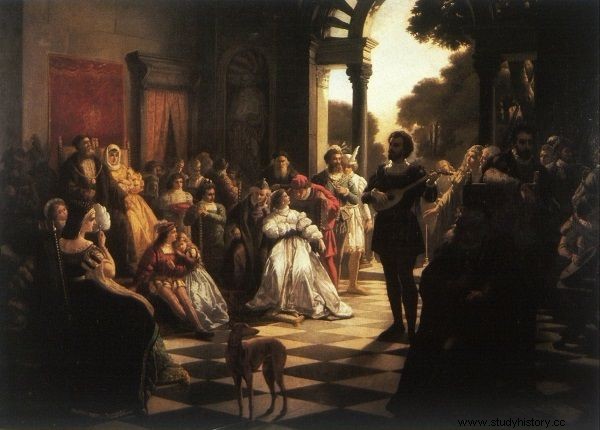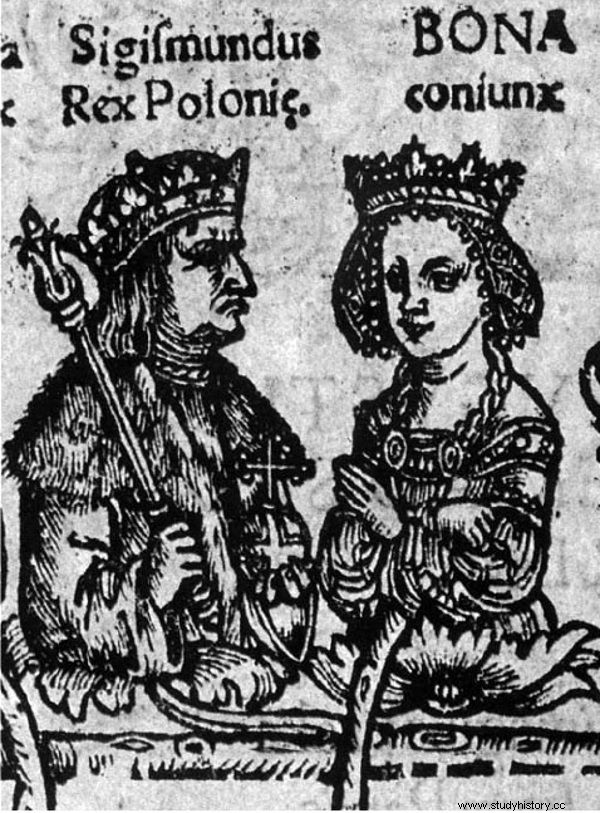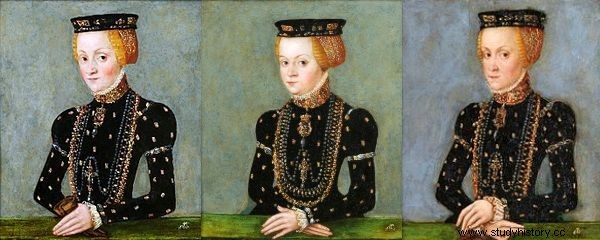Although almost every little girl dreams of being a princess, if she knew the fate of these royal daughters, she would probably change her mind. When they were born, their mother saw in them only a failure, because they were not the sons they wanted. She did not spend time on them, did not spend any money on them, but most of all - she skimped on their love.
It would seem that being born in the seat of Polish kings, in the chambers of the lightest lady, was like landing on down quilts wrapped in cool silk pillowcases.
A baby born in such circumstances could count on beautiful costumes, the best dishes and a herd of nurses pampering them. The whole problem is that most of the children of the famous Bona Sforza lacked the most important thing - motherly love.
When Sigismund the Old's spouse became pregnant for the first time, everyone was waiting impatiently for the birth of the heir to the throne. After all, this is why it was brought from distant Italy. When the time came for her solution, Bona gave birth to a daughter, Izabela, whom she looked at as a personification of failure. Contemporaries believed that the sex of her child depends on the woman's willpower. Apparently the temperamental Sforza was trying too little. She must have thought so herself. Nevertheless, she loved Izabela honestly and deeply.
Then, the second prince was born, Sigismund Augustus, who was to ensure the continuity of the dynasty. The next three daughters didn't matter anymore. After all, Anna, Zofia and Katarzyna were just girls.
Better and worse kids
Child psychologists say that unequal treatment of siblings by parents can cause great emotional problems in the future. Bona did not read education books and did not care too much about favoring two older children from the very beginning.

Being born in Wawel did not mean a perfect life. Especially if your mother would be Bona Sforza (Photo published under the CC BY-SA 4.0 license, author:Zygmunt Put Zetpe0202)
Sforza had a special bond with them. Zygmunt August was her apple of the eye, after all, it was his appearance in the world that strengthened her position as the queen and mother of the heir to the throne. She named Izabela after her mother and from the very beginning she saw unique features in her.
This favoritism did not mean that the three youngest daughters were despised or that their basic needs were not being met. They just couldn't count on much more.
When Bona and Zygmunt were away, the queen always wanted Izabela and Augustus with her. She did not hesitate to leave younger girls in the care of their nurses for months or even years. This approach had consequences. As Małgorzata Duczmal, Izabela's biographer comments:
[...] among the royal children there were two camps - one was created by Izabela and Zygmunt, and the other three younger princesses.
The best education
Bona came to Poland as a comprehensively educated young woman whom her mother, a seasoned politician, had been preparing for years to govern. Moreover, Zygmunt Stary's wife not only found herself at ease in the world of intrigue and conspiracies, but also surrounded herself with a cheerful and noisy court, full of artists and poets. The royal children were brought up in such an environment. It was certain from the very beginning that Bona would make an excellent education for them.
Maria Bogucka, the biographer of Anna Jagiellon, points out that it was for Izabela and Zygmunt August that the best humanist teachers were brought in. They were taught modern foreign languages and care was taken that they knew Latin perfectly, which in Europe at that time played a similar role as English today. In addition, the appropriate selection of readings was also taken care of.

The Wawel Manor was the best place to learn about culture. The painting entitled "The introduction of Italian music to the court of Sigismund I by Bona" says a lot about it.
Growing up at their mother's court, all of Bona's children learned Italian almost automatically. The chroniclers were rather not interested in the education of younger daughters, although it can be safely assumed that they took lessons from preceptors brought in for their older siblings. As proof, we can consider the admiration that Zofia Jagiellonka aroused at her husband's Brunswick court with her perfect knowledge of Latin.
Although Bona devoted all her energy and attention to the shaping of Izabela and Zygmunt August, in whom she saw the future of the Jagiellonian house, she probably did not neglect the education of younger children. She came from a country where women from aristocratic families were educated in all ways. If her own daughters, no matter how much she liked, received only a cursory education, it would be a disgrace to her.
Princesses without a castle?
The royal daughters did not live together. Bona always kept the eldest Izabela with her, the other three girls lived away from her. Małgorzata Duczmal comments on their status with these words:
The relatively low position of the three sisters in the Wawel hierarchy is evidenced by the fact that they did not have their own separate court. They lived together (in one room?) in the main building of the castle and they were probably served by courtiers and servants of Bona's court - in any case, there are no separate accounts that would prove that they had been assigned a separate retinue.

Did the lack of their own court mean that Zygmunt Stary and Bona were neglecting their children?
Against the background of the customs generally accepted in royal families, this was an unusual situation. The ruler's children usually had a separate court, which, although it was much smaller than the surroundings of the crowned parents, gave them prestige. This did not mean, however, that the youngest Jagiellonian women lived especially modestly or even poorly. As the court bills show, the royal daughters' chambers were lavishly decorated. They were full of expensive trinkets or religious symbols (expensive crucifixes and holy pictures painted with gold).
Were Polish princesses having fun?
The most interesting events took place next to them. The mother, who liked court entertainment, kept Izabela with her, not particularly worrying about her younger daughters. When the specter of plague air appeared over Krakow, she took her offspring and protected them in nearby Niepołomice. Parents devoted themselves to their favorite activity - hunting, and the children could spend time outdoors, in the surroundings of the Niepołomice Forest.
In order for Anna, Katarzyna and Zofia to have some fun while spending time at Wawel, they were brought from Italy, according to Maria Bogucka, dice, checkers, and also chess which then became very fashionable at European courts. However, embroidery, weaving, spinning and sewing seemed to be the greatest pleasure of the younger Jagiellonian women.
Over time, the princesses became skilled in these fields and prepared gifts for their loved ones by themselves. They were provided with the best materials from which to create their works. The princesses had at their disposal expensive fabrics, gold and silver threads, patterns imported especially for them from the south, and with time, as their craftsmanship grew, also pearls and jewels. And it was only the mother's interest that they constantly could not count on.

From the left, Katarzyna, Zofia and Anna - the three youngest daughters of Bona. Portraits by Lucas Cranach the Younger.
Bona did not rush to them even when a devastating fire broke out at Wawel and the princesses almost lost their lives. Of course, she became interested in her own property, consumed by the fire, but having looked at the treasury and inventories, she immediately abandoned her traumatized children again. Katarzyna, Anna and Zofia were to spend the next year in Krakow, while my mother stayed in distant Lithuania.
Unlike Izabela, who was quickly married off to a pretender to the Hungarian throne, the monarch did not take any interest in preparing the other daughters to marry. And if she was in the company of her daughters, it was only so that they would constitute an attractive set design for her. Interestingly, she always treated them as if ... they were one person. She bought them three identical necklaces. Three the same chains and the same cut collars.
"Even in the well-known series of portraits of the Jagiellonian family, made in the workshop of Łukasz Cranach the Younger, the princesses look almost identical," emphasizes Kamil Janicki in the biography of Bona Sforza and Anna Jagiellonka. - “They have the same dresses, the same ornaments, hairstyles and hats. This is by no means the result of the painter's laziness. It was just that Bona tried very hard to make her three daughters look like triplets. That made them the perfect background! ”
And to be anything more they could not count on as long as a mother lived, loving only her first daughter.
***
For Bona, three younger daughters were a burden. She could not expect that, years later, they would ensure the survival of her heritage. The unusual story of the hardened, despised, but also ambitious and simply indispensable for the Polish history of queens was presented in Anna Brzezińska in her latest novel. "Daughters of Wawel. A story about the Jagiellonian princesses ”
